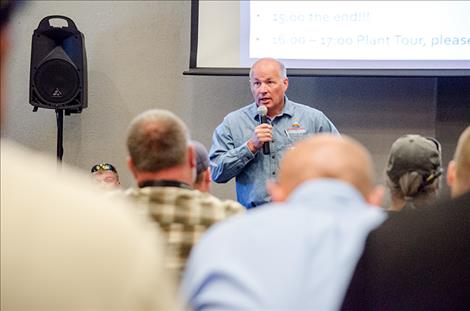Polson gets flooded in mock exercise
Hey savvy news reader! Thanks for choosing local.
You are now reading
1 of 3 free articles.
POLSON – In the unlikely event that something happens to the Selis Ksanka Qlispe Dam, an emergency action plan is tested and ready. On May 24, an emergency scenario was played out to test that plan.
A conference room at the KwaTaqNuk resort was full of personnel from real agencies including law enforcement, dispatch, an ambulance service, public and environmental health organizations, disaster services, county commissioners, volunteer agencies, and many more, ready to work on the mock problem.
The Federal Energy Regulatory Commission mandates that all hydropower projects have an emergency plan that is practiced annually. Energy Keepers, Inc. took over management of the dam in late 2015 for the Confederated Salish and Kootenai Tribes. EKI CEO Brian Lipscomb said this is the first time Energy Keepers has tested the emergency action plan.
Lipscomb said a structural failure has never happened at the dam. He said if something did happen structurally to the SKQ dam, water levels would not rise high enough to submerge Polson because the water would take a natural course down the Flathead River, although low level flooding could occur. Water might rise to lower areas of Polson including U.S. Highway 93 near Subway and at KwaTaqNuk, but natural restrictions and elevation would keep the water from moving into downtown Polson.
In an effort to give the room full of people a chance to practice a big event, the mock scenario involved the Hungry Horse Dam, located on the south fork of the Flathead River, 20 miles north of Kalispell. Lipscomb said water levels would rise and flooding would occur in Polson and towns near the Flathead River if something happens to the Hungry Horse Dam because it would push down a much larger amount of water.
For the mock scenario, agencies were split up and put in cubicle style rooms as if they were at the real buildings where they worked and asked to act like the scenario was real. A set of phone lines was connected inside the building so no one outside would get an accidental phone call and think the situation was real.
Soon after the exercise started, a phone call came in and Lipscomb answered. He was told that the Hungry Horse Dam was hit, maybe by a meteorite. The dam was gone. Flathead Lake was expected to rise by 15 feet. The scenario was bad. Lipscomb got out the emergency action plan and started calling people on his list.
In the real action plan, each person is tasked with calling another emergency service or government agency to make sure everyone is notified in the proper order so they can take action.
Lipscomb called the Montana Disaster and Emergency Service in another cubicle. “It’s time to implement the emergency action plan,” he said. He received dozens more phone calls and held a press conference to inform the public.
At one point, the power went out and he started working with his penlight. He said his feet would probably be getting wet from flooding if he was making the calls in Polson and the situation was real. The lights came back on about a minute later.
Within 7.5 hours, which was actually about an hour and a half into the exercise, the full impact of the flood occurred. Police increased patrols and people were moved to shelters if they needed it. Polson experienced flooding but not enough to evacuate people.
Water continued moving down the river, and most of the flooding occurred in Dixon and Plains where the land surrounding the river has less of a natural barrier. Towns like Ronan and St. Ignatius were not impacted.
Lake County Office of Emergency Management Director Steve Stanley stood up during the second mock press conference to say that people need to be careful of the debris in the lake and the river and that the cause for the dam’s failure was still under investigation. Stanley plays a pivotal part in organizing emergency services during real disasters.
The practice exercise wrapped up about three hours after it began. Hundreds of notes were recorded about how the incident was handled to improve it for next time. Lipscomb said that many people including those in the hydropower industry are constantly working to ensure the public’s safety.
“It is common practice to address the possibility of a natural disaster; it’s highly unlikely, and highly infrequent, but we need to be prepared,” he said.
Chief Dam Safety Engineer and Site Safety Officer Matthew A. Pruchnik said the mock exercise was an overall success. He thanked everyone that participated. “We couldn’t do this if they didn’t show up.”
















